#Drivetrain technology
Explore tagged Tumblr posts
Text
Maintenance Tips: Keeping Your Drivetrain in Top Shape
https://gob.stayingalive.in/unleashing-the-thrills-of/maintenance-tips-keeping.html Maintaining your motorcycle’s drivetrain is crucial for optimal performance and longevity. Here are some practical tips to ensure your chain, belt, or shaft drive remains in excellent condition. Chain Drive Maintenance Lubrication: Regularly lubricate the chain to reduce friction and prevent rust. Tension…

View On WordPress
#automotive#Belt drive motorcycles#bike#cars#Chain drive motorcycles#Drivetrain technology#Electric motorcycles#Future motorcycle technology#Good Old Bandit#Gud Ol Bandit#Hybrid motorcycles#Lightweight materials#motorcycle#Motorcycle drivetrains#Motorcycle efficiency#Motorcycle maintenance#Motorcycle performance#News#Sanjay K Mohindroo#Sanjay Kumar Mohindroo#Sanjay Mohindroo#Shaft drive motorcycles#Smart drivetrains#Sustainable motorcycles#touring motorcycles
1 note
·
View note
Text
Dodge's Electric Evolution: Bringing the V8 Rumble to the Electric Arena
In an ambitious move to marry the past with the future, Dodge is setting the stage to infuse its electric cars with the soul-stirring sounds and dynamic feel of its legendary V8-powered muscle cars. This innovative endeavor aims not just to preserve the iconic auditory and tactile experience of driving a Dodge muscle car but to elevate it within the realm of electric vehicles (EVs). The Electric…
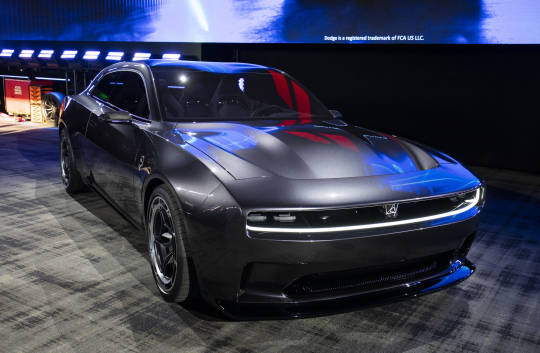
View On WordPress
#400V and 800V Architectures#Active Vibration Enhancement#Automotive Innovation#Automotive Technology#Car Enthusiast Culture#car safety features#Charger Daytona#Dark Matter Sound Profile#Dodge Charger Electric#Dodge Electric Muscle Car#Dual-Motor Drivetrain#Eco-Conscious Driving#Eco-Friendly Muscle Cars#Electric Cars Safety#Electric Muscle Car Sound#Electric Power Upgrades#Electric Vehicle Development#Electric Vehicle Experience#Electric Vehicle Innovation#Electric Vehicle Market#Electric Vehicle Performance#Electromechanical Shifting#eRupt Multi-speed Transmission#Fratzonic Chambered Exhaust#Future of Driving#High-Performance Electric Cars#Hybrid Electric Vehicles#ICE Simulation Technology#Multi-speed Gearbox#Muscle Car Legacy
2 notes
·
View notes
Text
All Wheel Drive Market Poised to Register High Growth Due to Rising Demand for Enhanced Safety

The all wheel drive market has been gaining significant traction over the recent years owing to various advantages associated with all wheel drive vehicles such as enhanced traction, stability and safety even during harsh weather conditions. All wheel drive systems help distribute the engine power to all the four wheels of a vehicle and offer improved acceleration, handling, and control. Increasing concerns regarding safety among consumers along with strict emission norms have been prompting automakers to incorporate advanced driveline technologies in vehicles. The rising demand for premium and luxury vehicles coupled with growing off-roading and winter sports activities is also augmenting the sales of all wheel drive cars.
Global all wheel drive market is estimated to be valued at US$ 38.24 Bn in 2024 and is expected to reach US$ 65.27 Bn by 2031, exhibiting a compound annual growth rate (CAGR) of 7.9% from 2024 to 2031.
Key Takeaways Key players operating in the all wheel drive market are AB Volvo, American Axle Manufacturing, Inc., BorgWarner Inc., Continental AG, Dana Incorporated, GKN Plc, Honda Motor Company Ltd., JTEKT Corporation, Magna International Inc., Nissan Motor Co., Ltd.,, Tesla, Inc., Valeo SA, ZF Friedrichshafen AG. The All Wheel Drive Market Growth is expected to witness lucrative growth opportunities owing to rising demand for SUVs and crossovers especially in the Asia Pacific region. Growing customer inclination towards enhanced vehicle performance even in adverse weather and road conditions is boosting the sales of all wheel drive vehicles. Rapid urbanization along with increasing construction of roads in rural areas is further expanding the outreach of all wheel drive vehicles globally. Major automakers are focusing on geographical expansion plans to target untapped growth opportunities in developing nations. Market drivers Strict emission regulations concerning fuel efficiency and safety are prompting automakers to adopt advanced driveline technologies in vehicles. Proliferation of automatic transmission systems along with developments in torque vectoring and electronic stability control systems is fueling the adoption of All Wheel Drive Market Size and Trends. Increasing disposable income and changing lifestyles have augmented the demand for premium and luxury vehicles equipped with enhanced drivetrain capabilities. Demand for all wheel drive from off-roading and winter sports enthusiasts is further propelling the market growth.
PEST Analysis Political: Regulations related to vehicle emission norms, safety standards, and taxation policies related to vehicles Economic: Fluctuations in the disposable income levels affecting consumer spending on vehicles and rising fuel prices encouraging more sales of fuel efficient vehicles. Social: Increasing preference of customers for comfortable, safe, and high-performance vehicles leading to higher demand for AWD vehicles. Technological: Advancements in driveline systems, electronics, and transmission technologies helping manufacture more efficient and affordable AWD vehicles. In terms of value, the market is currently concentrated in North America and Europe. North America is a leading revenue generator attributable to high demand for luxury and high-performance vehicles in U.S. and Canada. Moreover, extreme weather conditions necessitating better traction and control also drive sales. Similarly, Europe is another major regional market due to proliferation of high-end hatchbacks, SUVs, and crossover vehicles across major countries. Among regions, Asia Pacific is projected to witness fastest growth during the forecast period. Factors such as rapidly growing production and sales of vehicles, extensive rural areas and mountainous roadways necessitating better handling, and improving consumer affordability are estimated to primarily drive the demand for AWD vehicles across emerging economies of India, China, and ASEAN countries. The growth is also supplemented by investments by global OEMs to tap into the regional markets.
Get more insights on All Wheel Drive Market
About Author:
Ravina Pandya, Content Writer, has a strong foothold in the market research industry. She specializes in writing well-researched articles from different industries, including food and beverages, information and technology, healthcare, chemical and materials, etc. (https://www.linkedin.com/in/ravina-pandya-1a3984191)
#Coherent Market Insights#All Wheel Drive Market#All Wheel Drive#All-Wheel Drive#Four-Wheel Drive#4WD#Traction Control#Off-Road#Car Technology#Vehicle Stability#Drivetrain#Automotive#SUV#Crossover
0 notes
Text
Jeep Wagoneer S Unveiled: An Electrifying American Alternative to the Range Rover Velar
In a recent turn of events, images of the highly anticipated all-electric Jeep Wagoneer S were inadvertently shared on Jeep's social media platforms before being swiftly removed. Despite the deletion, the digital world ensured their permanence, offering the public an early peek at this groundbreaking SUV. Initially spotted by Mopar Insiders, these images emerged just a week after Jeep teased the vehicle, sparking widespread interest.
The Wagoneer S marks a departure from traditional Jeep designs, embracing a more streamlined and elegant aesthetic. This evolution in styling seems to draw inspiration from industry competitors, notably exhibiting elements reminiscent of Range Rover models. The rear profile bears a striking similarity to the Velar, while the intricate detailing echoes the Evoque's design. Additionally, the front fascia subtly nods to the Land Rover Range Stormer concept.
Aerodynamic efficiency is at the forefront of the Wagoneer S design, as evidenced by features like recessed door handles. The SUV also sports a distinctive rear spoiler that merges seamlessly with the roof trim, extending over the rear windshield. This design choice not only enhances the vehicle's sporty demeanor but also maintains a traditional SUV silhouette while offering a more modern, coupe-like profile. This could potentially improve range, albeit possibly at the expense of interior headroom.
The Wagoneer S also boasts an attractive two-tone paint option, a panoramic sunroof, and a faux front grille with Jeep's iconic seven-slot design, further enhancing its visual appeal.
Despite sharing the Wagoneer name, the electric iteration stands apart from its full-size counterparts, the Wagoneer and Grand Wagoneer. It aligns more closely in size with the Grand Cherokee, defying initial size expectations.
Jeep promises impressive performance with the Wagoneer S's dual-motor 4xe drivetrain, delivering an estimated 600 horsepower and a swift 0-60 mph acceleration in just 3.5 seconds. This suggests a focus on on-road performance for this electric vehicle.
However, true to its Jeep heritage, the Wagoneer S is equipped to handle mild off-road challenges, featuring a standard all-terrain management system. For those seeking a more robust electric off-roading experience, Jeep hints at the upcoming Recon model, also slated for release this year.
The Wagoneer S will be Jeep's debut fully electric vehicle in the U.S. market, following the Avenger EV in Europe. Production is set to take place at the Toluca Assembly Plant in Mexico. The vehicle is based on Stellantis' STLA Large architecture, which is expected to be the foundation for several new EVs by 2026.
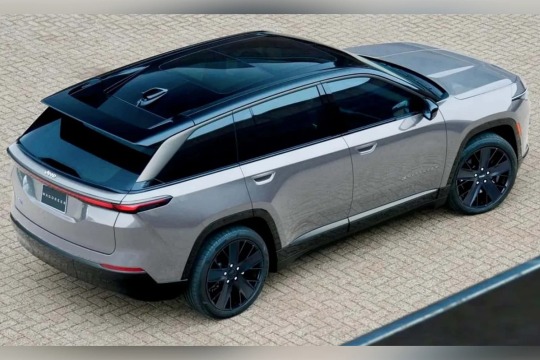




#Jeep Wagoneer S#electric SUV#luxury electric vehicle#Range Rover competitor#Jeep electric model#SUV styling#aerodynamic design#high-performance EV#4xe drivetrain#automotive trends#sustainable driving#electric vehicle technology#Jeep launch#automotive updates#eco-friendly transportation
0 notes
Text
catch me if you can
street racer! ellie williams x fem! reader

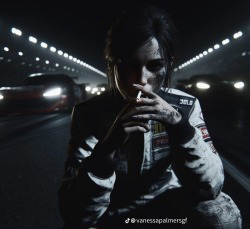

summary; heat rises on the streets, blood pumps with adrenaline in the race, and bad memories come up to the surface with a swing of the steering wheel.
cw; tension, swearing, mentions of death and death of a fictional character, anxiety… in the future there would be +18 content!
special thanks to @winfleurs and @atomicami for inspiring me i luv u! 🎀
“dina! wait up!” you screamed, your heels making it not quite easy to run after your best friend.
your ears were buzzing with the roaring of the audience and the car’s engines. it was a fresh saturday night, and the city seemed as bright as a constellation. adrenaline was pumping through your veins, you shouldn’t be out today. in fact, you’d sneaked out of your house. but you couldn’t help it if your friend asked for it so badly. her boyfriend, jesse, was supposed to be racing today. there was a lot of money on the line. probably about 500k. and dina had to be there. you know, the ‘good luck’ kiss and all that.
the cars looks amazing, modified with the newest technology. you could see the NOS tubes peeking though, ready to push though the chambers of the cars and burn the tires in the asphalt.
shit, you were getting excited.
you followed your friend through the crowd, trying to not lose her black wavy hair out of sight.
“jesse!” she screamed, a huge smile on her features as she ran towards the cars and her boyfriend, jumping onto his arms.
“hi beautiful.” he smiled, giving her a kiss as he held her. you made a gagging sound that made them laugh and pull apart.
“nice to see you too, jesse.” you said as you met up with the two of them. jesse chuckled.
“hey trouble maker, what are you doing here?”
“oh, you know… being a good best friend and all that.” you rolled your eyes, a playful smile on your lips.
“of course.” he hummed, squinting his eyes.
“although i really wanted to see you lose too.” you added and he laughed.
“there it is. i could see it coming.” you winked at him.
“i see you’ve got competition.” you looked around to the cars placed for the race. and you whistled. “a 2015 Lykan HyperSport? that’s gonna be hard to beat.” jesse frowned. “but of course yours is not that bad…” you placed your hand on its surface. “Nissan Skyline GT-R R34… 1999 right?” you inquired and he nodded.
dina seemed just as surprised as him.
“yeah… how do you know all this stuff about cars?” you froze. shit.
“uhh…” you shrugged. “my father. he’s a fanatic.” you quickly spurted out, and the two of them nodded, letting it slide. ‘cause they couldn’t think anything else about it, of course. you were no longer in LA, you were safe.
you sighed. almost fucked it up.
“hey, jess!” the three of you turned around at the sound of a low and sultry voice. your eyes met a pair of evergreen ones, silky auburn hair —tied half and half on a messy bun— and freckled cheeks. she was seating on the hood of her car, girls with tiny skirts and exposed cleavages surrounding her. her legs were spread, a black tank top hugging her chest and toned abdomen, leaving her strong arms exposed.
she was hot. really hot.
“yo williams.” jesse smirked. “ready to eat dirt?” she scoffed, showing off a confident smirk.
“you talk too much for someone who hasn’t beaten me once.” people around you hollered.
“and you talk too much to have that shit of a car.” you huff, and she arched her eyebrows. “Subaru WRX. year 2008.” you pointed out, your heels clicking as you got closer. “i’m sorry for your wallet. the engine and drivetrain must have given you a lot of problems.” you saw the way her jaw ticked and you smiled. “uuuh, seems like a touched a tender spot, didn’t i? i mean subarus are impressive. but not even an STI? come on. you hurt me.” you pouted and she chuckled.
“well, look at that. here i thought your pretty face would be the most interesting thing about you. but you’ve got brains.” she said, jumping off of the hood of her car, getting closer to you as she eyed you up and down.
“not like your kitties here.” you nodded at the girls and they all stared dirtily at you, what made you smirk.
“careful doll, they might scratch you all up.” she warned, playfully, so close to you you could smell her perfume. “and we wouldn’t want that beautiful face of yours to go to waste, do we?” you smirked.
“i would like to see them try.” you muttered, leaning until your faces were mere inches away. she pursed her lips and took a look at you, at your exposed legs and cleavage, beautiful hair and glossy red lips. you had gone for a simple tight tube leather dress that pushed up your tits a little bit too well, and a pair of red thin high heels. a red pendant hanging from your necklace.
“see something you like, ‘williams’?” you inquired, sultry, teasingly and she smirked.
“maybe.” she tilted her head slightly backwards. “what about you? you see something you like?”
“i do…” you nodded, droopy eyes on her own green ones and she smiled. “your car.” she let out a sarcastic laughter, shaking her head.
“but weren’t you just saying how much of a shit it was?” she inquired, eyebrows arched in disbelief.
“now it is. it won’t be once i’ve got my hands on it and touch her all up.” you said as you stared at the cherry red car. the people surrounding you let out ‘uuu’s that made you smile. “you know… a short throw shifter, maybe a new intercoolers…”
“and how are you gonna do that, princess?”
“with a race.” the crowd roared and your friends frowned. dina approached you.
“are you crazy?! do you even know how to race?” you looked at her, and took one of her hands.
“dina… i’ll explain later, okay? but now i need you to trust me on this one, alright?” jesse and dina looked at you, into your eyes, and saw your determination. silently, he handed you his keys.
“if you’re gonna race, you’ll need a car.” you looked at him, and he smiled. you returned it, taking the keys. “if you lose i’ll kill you.” he warned though, and you laughed.
“i never lose.” you promised.
“what do i win if you do?” ellie stepped into the conversation, eyebrows raised. “need to hook me in, gorgeous, i’m betting my car after all.”
“i’ll tell you what.” you smirked, turning towards her. “since it’s not gonna happen. i’ll bet you anything you want.”
“anything i want?” she inquired and you nodded. “don’t pull back later on your promise, princess.”
“i won’t.”
-
you could feel the adrenaline pumping through your veins, the tingling of your hands. you pressed on the gas, hearing the engine roar, and your heart stammered. shit. it’s been so long.
you had promised yourself you wouldn’t do it ever again. but how could you get away from all of this? from the only thing that made you feel something? that made you weak on your knees and your heart race? it was like a drug. every time you took it you’d find yourself begging for more. you needed it on your system.
you had learned how to race since a very early age, even before you had enough age to get your license —yeah, you got in trouble with the police more than once, but they could never catch you—. and even if you loved it, you’d left it all after your best friend had died while racing, in the hands of a crazy dick who made him crash against a building, making the NOS tanks blow up and burning him alive.
you still could remember your screams, how your friends had grabbed at you so you wouldn’t get closer. ‘let me go! let me fucking go!’
you’d watched the only person that got you and unconditionally loved you die in front of your eyes.
after that you’d used the millions of dollars your family name had to drown your sorrows in alcohol and drugs, getting away from the city that had taken away your everything from you and building a brand new life where nobody could know you.
you’d been hard to get to know, always having everybody at an arm’s length until dina had come along, with her stupid smile and warm personality bringing you back to life. you’d forever be grateful to and for her. but her past was something you’d never talked about, and she didn’t want to force you into it.
“i see you shaking there, princess. scared?” williams screams from her car, who just had positioned itself to your right. you scoffed.
“oh yeah, terrified.” you sarcastically said, and she smirked.
“don’t worry babe, you can always sit on my lap later, i have something that will calm you down.” she winked and you rolled your eyes.
“no thank you, once i’m done i’ll be sitting on your car and driving back to my house.” you winked back, and she chuckled, mouthing something to herself that you couldn’t figure out.
“you guys readyyyyyy?!” a girl in a mini skirt came in between the two cars, a gun in hand. the audience roared, and so did your car. there were phones everywhere, recording the impending race —and your victory—.
you bit down on your lip. you were gonna make win that pretty girl, in heels.
“set!” another girl to your right yelled, and your engine roared again, the tires burning.
“ready!” another to your left, one more roar.
“go!” the girl with the gun shot up to the sky, and before you knew you were flying. the world stopped. there was no future. no past. just the present. just that moment.
ellie took the lead, and she smirked to herself, looking at your car through her mirrors. but she just had to take her eyes away from you for two seconds to lose you. “what the-“
she took the curve, and with a honk, you drifted right beside her, in a swift motion getting in front of her backwards to the road, facing her car. you smiled at her, and send her a kiss with one of your hands before harshly spinning the wheel and drifting once again to face forwards, using the NOS to catapult yourself through the asphalt. you relished on the shock of her face. god you could never get used to it. it never got old.
ellie cursed, following right behind you, adrenaline pumping through her body.
“i’ve finally got you.” she smiled, changing gears and speeding up. another closed curve came into your view and you sped up, in a quick movement changing gears and pulling on the break as you harshly manhandled the steering wheel. you could almost see everything on slow motion, the people outside of the car roaring as you perfectly drifted in an U shape.
you screamed, euphoria in the pit of your stomach. ellie used the inertia to pull up by your side, lowering her window. you did the same. you two were on the final straight line. “you ready to lose princess?” she inquired, and you scoffed.
“catch me if you can, williams!” you screamed, and changed gears before pressing the gas. you press the NOS button, the strength making your back press tightly against your sit. you flew through the straight line, ellie copying you and keeping up with you. you could see the finish line getting closer and closer, and the speedometer getting higher.
you knew you couldn’t over do it, the crowd was waiting for the winner there, you couldn’t hurt them, you wouldn’t.
100mph, 125mph, 150mph, 165mph.
“3…2…1…” and just as you crossed the finish line, mere inches ahead from ellie, you harshly rotated the wheel, drifting as you stepped and pulled on both breaks, the tires burning against the asphalt and leaving marks as you finally stopped the car. the crowd roared and quickly approached you. dina and jesse were hollering.
you stepped out of the car with a smile on your face, your best friend jumping to hug you and jump into your arms, making you laugh.
“what?! i mean- what?!? that was amazing!!! since when could you race?!!?? oh my god!!!” you chuckled, trying to calm her down.
“i’ll tell you everything about it later, alright?” she nodded. jesse tried to say something but he was out of words. “it’s okay big boy, don’t waste your breath.” you tapped her shoulder, and he scoffed. “and now…” you turned around, watching ellie as she stepped out of her car. “i’ll be taking my prize.” you smirked, spreading out your arm and showing her your palm. she tilted her head to the side, a playful smile playing on her lips.
“sure. but first aren’t you going to introduce yourself for me, princess?” she inquired. “or should i do it… viper?” your blood froze, as well as the whole crowd. ellie smirked. “you really thought i wouldn’t recognize those drifts?” you quickly got closer to her, your breaths mingling.
those surrounding you started mumbling. your breath was shaky and your body, still filled with adrenaline, slowly filled with anxiety and bad memories.
“viper the street racer?”
“no way!”
“she disappeared years ago, is it really her?”
“i would shut up if i were you.” you hissed, and she leaned in, the smirk on her lips growing. your lips were almost brushing, and with the hand in which she had her keys, she cupped your chin.
“why don’t you make me?”
you needed to get out of here.
why… why now? why after all this years was your past catching up to you?
you quickly took her —your— keys, watching her smile as you got into your new car and started it. the crowd was unraveling and you knew soon they’d start either jumping at you or taking pictures to expose you.
“see you soon, princess!” she screamed as you drove out of there, groaning at the buzzing of your phone. “i caught you.”
-
a/n; ty’all for 7k! i’m so happy that such a large number of people enjoys my work :(🎀 i love u!! also hope you liked this fic! would you like a part 2? let me know!
#ellie the last of us#ellie#ellie x fem reader#tlou ellie#ellie williams#ellie x you#ellie williams x you#ellie williams tlou#ellie tlou#ellie williams x reader#ellie williams fic#ellie williams fanfiction#ellie williams angst#ellie williams smut#ellie smut#ellie x reader#ellie x y/n#ellie williams imagine#ellie williams fluff#ellie williams x female reader#tlou#tlou fanfiction#tlou fic#tlou imagine#tlou smut#tlou fluff#tlou x reader#tlou2#tlou part 2
1K notes
·
View notes
Text
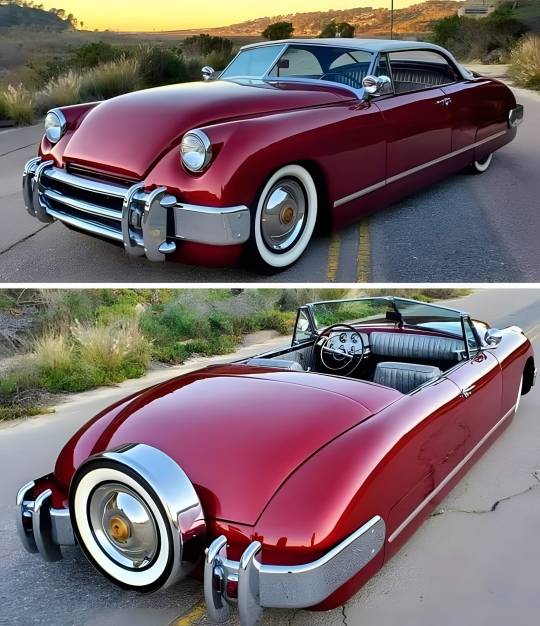
Custom 1953 Muntz Jet Convertible
This 1953 Muntz Jet convertible underwent a three-year custom build under previous ownership, and it was purchased by the seller in 2021. The car is powered by a fuel-injected 5.7-liter LT1 V8 engine paired with a four-speed automatic transmission and a Ford 9″ rear end, and it is finished in Apple Pearl with a white Carson-style removable top over gray snakeskin-style Naugahyde upholstery. Features include custom bodywork, an Art Morrison frame, power-assisted steering, four-wheel disc brakes, airbag suspension, Painless Performance wiring, and more modified and fabricated details. This custom-built Muntz is now offered with a copy of Rodder’s Journal magazine featuring a story on the build and a clean California title in the name of the seller’s business.
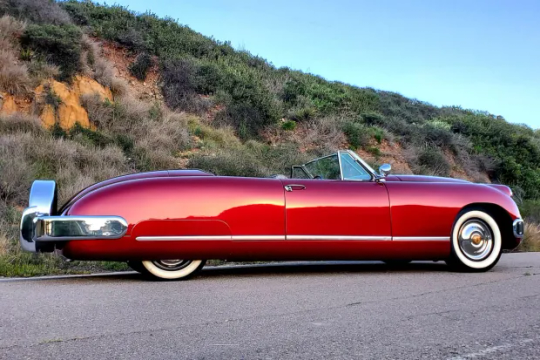
Custom 1953 Muntz Jet Convertible
The steel, aluminum, and fiberglass body is mounted on an Art Morrison ladder frame that was boxed and finished in semi-gloss black, and the floor was raised 3″. The exterior was repainted in a Sherwin Williams two-stage Apple Pearl mixed by the late Stan Betz. Features include a chopped Duvall-style windshield, 1950 Chevrolet headlights, dual Appleton spotlights, 1951 Ford Victoria side windows, and a white removable Carson-style top fabricated to match the height of the chopped windshield. Additional equipment includes color-matched rear fender skirts and chrome bumpers. Wear from fitting the top is noted on the rear deck.
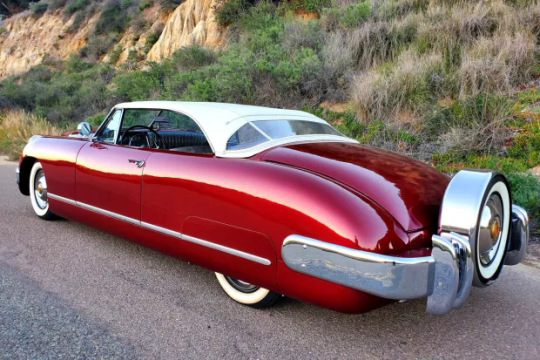
Custom 1953 Muntz Jet Convertible
Steel wheels sourced from a 1976 Dodge measure 15″ and are mounted with Cadillac Sombrero-style covers and whitewall tires. A matching spare fitted with a BFGoodrich Silvertown tire is mounted within a rear-mounted Continental-style chrome carrier. A Mustang II front end accommodates power rack-and-pinion steering , and the car rides on an electronically-adjustable Air Ride Technologies airbag suspension system along with 2” lowered front spindles, Strange Engineering tube shocks, a rear Panhard bar, and front and rear sway bars. The seller reports that the front control arm bushings were recently replaced.
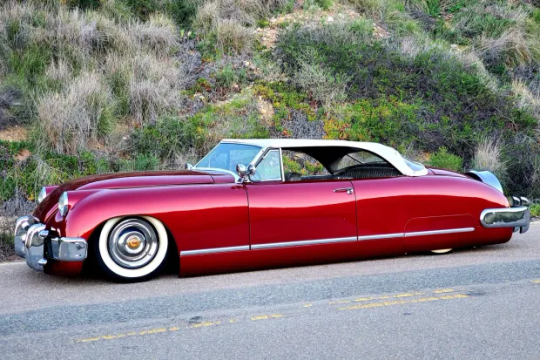
Custom 1953 Muntz Jet Convertible
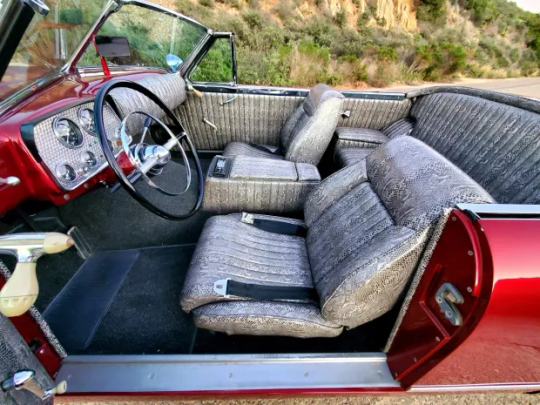
Custom 1953 Muntz Jet Convertible
Braking is handled by GM G-body-sourced calipers matched with Ford Granada discs up front and Ford SVO-specification calipers and discs at the rear.
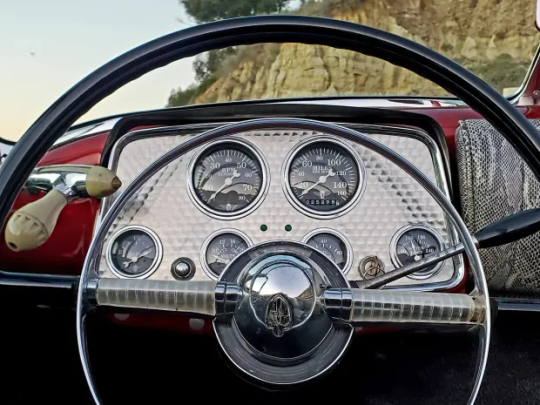
Custom 1953 Muntz Jet Convertible
The cabin was customized by Jim’s Auto Trim of San Diego, California, and features Glide bucket seats and a rear bench trimmed in gray snakeskin-style Naugahyde upholstery, along with matching treatments for the dash trim, headliner, and door panels. Additional equipment includes a 1952 Lincoln steering wheel mounted to a shortened Lincoln steering column, gray cut-pile carpet, and a Pioneer stereo housed within a custom center cubby.
The engine-turned “Hollywood” instrument cluster houses Stewart Warner gauges consisting of an 8k-rpm tachometer, a 160-mph speedometer, and auxiliary readings for fuel level, battery charge, oil pressure, and water temperature. The five-digit odometer displays 25k miles, though total chassis mileage is unknown. A Lokar pedal assembly was fitted during the build.
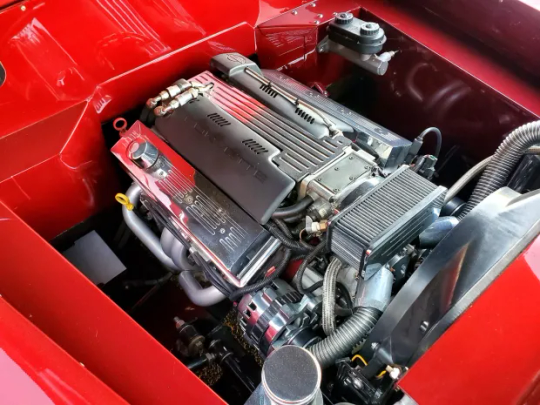
Custom 1953 Muntz Jet Convertible
The Corvette-sourced 5.7-liter LT1 V8 features a polished fuel intake manifold along with billet aluminum valve covers, and additional features include an Opti-Spark distributor, a Griffin aluminum radiator, and a wiring loom sourced from Painless Performance Wiring. A set of long-tube headers are connected to a 2.5″ exhaust system equipped with dual Dynaflow mufflers. The seller reports that the oil was recently changed.
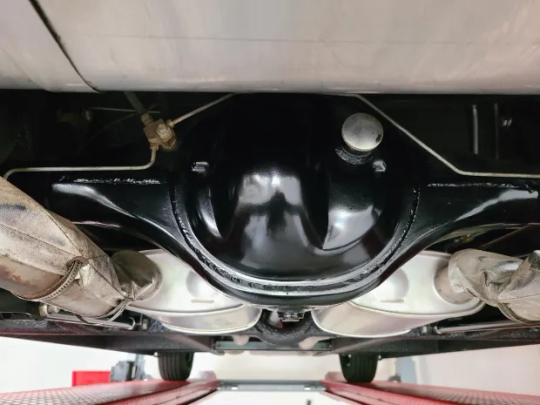
Custom 1953 Muntz Jet Convertible
Power is routed to the rear wheels via a four-speed 4L60E automatic transmission and a Ford 9″ rear end with with 3.55:1 gears and Strange Engineering 31-spline axles. Additional photos of the underside, drivetrain, and suspension components are presented in the gallery below.
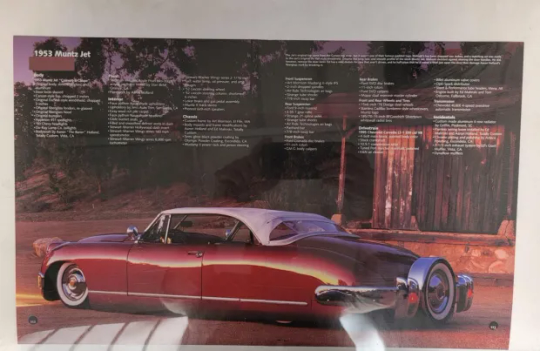
Custom 1953 Muntz Jet Convertible
The car was featured in issue #36 of Rodders Journal magazine
#Custom 1953 Muntz Jet Convertible#Custom 1953 Muntz Jet#Muntz Jet Convertible#Custom Muntz Jet Convertible#Muntz Jet#Convertible#car#cars#muscle car#american muscle
110 notes
·
View notes
Note
Tank Man! A hypothetical for you.
How would you modernize a T-10M to nest survive and fight on the current battlefields of 2024 or later?

Couple of scenarios:
1) It is 2024, current day. You can change whatever you want except the actual layout of the vehicle, and assuming the new systems will fit/can be easily made to fit into the existing architecture of the tank. You have an unlimited budget.
2) Same as above, but you cannot change the gun or other major systems (engine, tracks/suspension, built-in armor, etc), but you can upgrade it in other ways (applique armor, new sensors, etc). You have an unlimited budget for add-ons.
3) It is the mid 2030s after a nuclear apocalypse. You are a post-Russian/Eastern European warlord who found a serviceable T-10M (I.e. it can move, it's not overly rusty, the gun still works, you have ammo for it, etc), and want to upgrade it by cannibalizing bits from the various knocked NATO and Russian tanks left over from the conventional stages of WW3. Your budget is effectively zero, so you can only salvage parts to fit into the tank. What do you do to upgrade it?
Well, this is a bit of a tough one.
For the first scenario, I'm going to gut the whole damned thing. New main gun, to bring it in line with modern ammunition and technology standards, new engine and transmission, since that was one of the IS-8s main flaws. I'd also dig into the C4I of the tank, and bring it up to standard, with modern fire control, sensor suites, etc. I'd also go in and apply a lot of ERA and some soft-kill APS, since that armor isn't going to hold up well to modern fire.
For the second, it's really going to come down to doing everything you can to make the tank more survivable. Applique armor, ERA, APS systems, to be honest, a lot of the stuff we're seeing in Ukraine right now would make the core of the upgrades.
For the third? It's all going to come down to finding parts that are simple and easily replaceable. FCS on an Abrams? Sure, those are going to be a dime a dozen. Loitering munitions launcher on a KF51? Good luck finding ammunition or repair materials for that. However, what's really going to be the issue with an unmodified T-10M is the engine and transmission, which is going to be borderline impossible to replace or repair, given that it's from the 50s, and drivetrain issues were a major part of what got Soviet Heavy Tank development canned in the first place.
26 notes
·
View notes
Note
do you train spot? If so can you send me some interesting photographs you’ve taken of trains you like. What’s your favorite train and why? For me I have a love and passion for steam locomotives and the various drive wheel configurations we saw as the technology progressed. I love the new diesel electric drivetrains of modern trains but nothing can beat the appearance of a steam engine
Yes when I can but unfortunately the Railroad lines are on the other side of the city from where I live
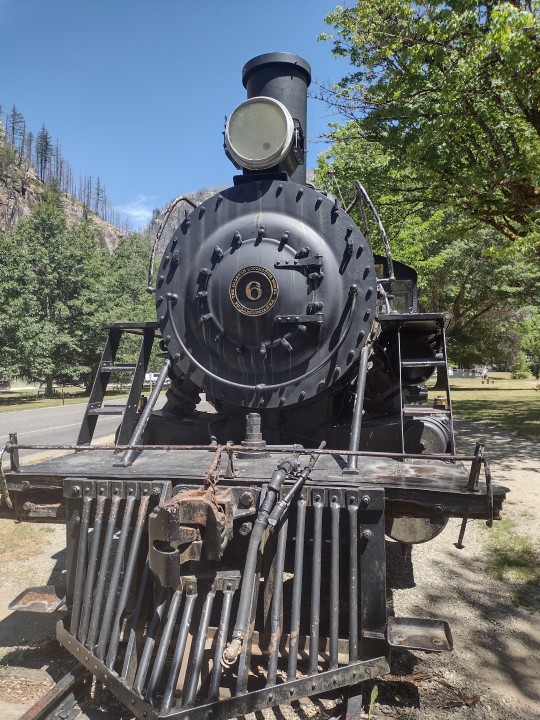









25 notes
·
View notes
Text





Mercedes Benz F500 Mind, 2003. Presented at the 37th Tokyo Motor Show, a mobile testbed for a number of in-car information features as well as driveline technology and safety. It was powered by a Diesel V8 hybrid drivetrain
#Mercedes-Benz#Mercedes Benz F500 Mind#2003#concept#experimental car#research vehicle#futurtistic#V8#hybrid#glass roof#suicide doors#37th Tokyo Motor Show
101 notes
·
View notes
Text
The ‘Modena Monster’: The 1955 Ferrari 410 Sports Spider by Scaglietti - a storied history
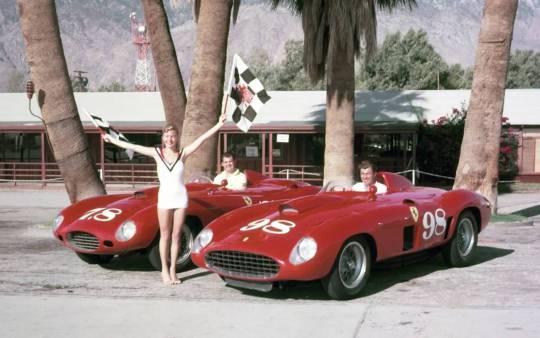
Mr. Ferrari told me this was the best Ferrari he ever built.
- Carroll Shelby on the 1955 Ferrari 410 Sport Spider by Scaglietti.
Why do so many of us find sports cars irresistible? Of course, it would be impossible to isolate exactly what it is about a well-designed sports car that engenders such attachment, but there are some factors that would logically contribute to the commonly seen love affair between men (and yes, women too) and their sports cars.
It seems as if much of the attraction is grounded in symbolism. Racing cars have long been portrayed as sources of freedom. Talented drivers are left unencumbered by the limitations of our lives driving pedestrian automobiles. They are seen as having a uniquely freedom to test their limits against nature. In such circumstances the driver is not boxed in like others. He can tackle any unencumbered road using all his God given skills while being completely open to the elements of chance and fortune. The source of that freedom from the adrenaline rush is the need for speed.
But speed is tethered to design and engineering innovation. We live in a world that worships at the altar of technological advances. The sports car is a moving amalgamation of technical expertise. Racing cars are a bundling of technological miracles. From aerodynamic styling to compact yet powerful engines, they represent the cutting edge of technological design. In a society entranced by technology and innovation, the sports car has an iconic appeal that is difficult to equal.
For me though, it’s stories behind the drivers and the feats of engineering design that make me an unabashed petrol head. It’s not just appreciating the feats done in the car by magnificent drivers of their age. But recognising each car has a story too. Every car has a storied history.
And this is the story of one of my favourite racing cars in motor sports history.
The 1955 Ferrari 410 Sport Spider by Scaglietti has the reputation as an incredible and rare sports car that was driven by some very famous racing figures. In addition to Carroll Shelby, who would later join Ford in beating Ferrari at the 24 Hours of Le Mans, the car was driven by the legendary Juan Manuel Fangio and by Phil Hill, Formula 1 champions both, as well as Enzo Ferrari himself.
The 1955 Ferrari 410 Sport Spider by Scaglietti was birthed by Enzo Ferrari and Sergio Scalietti.
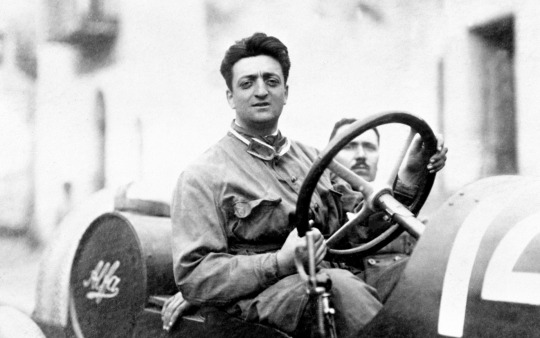
At a time when series car making was still in its infancy at his company, Enzo Ferrari would manufacture only the rolling chassis and drivetrain. For the bodies, Enzo employed several different coach-builders to ��clothe” his machines. Performance was Enzo’s utmost concern and thus, styling came second. Still, he was acutely aware of how styling impacted peoples’ perception of his company and the cars that bore his name. Luckily Ferrari’s victories on racetracks caused the industry’s bespoke coach-building companies to want to work with the firm, and show what they could do on the Ferrari chassis. One of these firms was Carrozzeria Scaglietti.
Sergio Scaglietti, got his start working on Scuderia Ferrari’s Alfa Romeos (then Alfa’s racing arm) before World War II. After the war he opened a repair shop in Maranello, not far from the Ferrari factory, where he primarily repaired the bodywork of damaged race cars for gentleman racers. When one such racer brought his damaged race car to Sergio’s workshop, the quality of the repairs and re-bodying caught Enzo’s eye, and by 1955 Sergio was put in charge of bodying the majority of Ferrari’s competition cars.
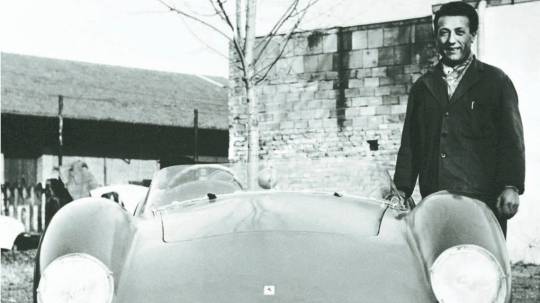
Additionally, Sergio secured a loan from Enzo himself to start his own coach-building film, the aforementioned Carrozzeria Scaglietti. This was quite an honour because at the time there were quite a few established coach-builders who already worked with Ferrari including Bertone, Zagato, Vignale, Touring, and Pininfarina. Sergio won Enzo’s trust not only because of his skills with metal, but also because of his relationship with, and support for, Enzo’s son, Dino, who died in 1956.
With Scaglietti now an officially sanctioned Ferrari coach builder, he received chassis’s directly from the Ferrari factory for coachwork. By his own admission, he designed all his shapes “by [his] eyes alone,” letting his own “good taste, understanding of aerodynamics, style, and function” dictate his designs. He rarely drew out his designs in advance, instead preferring to shape the body directly over the chassis.
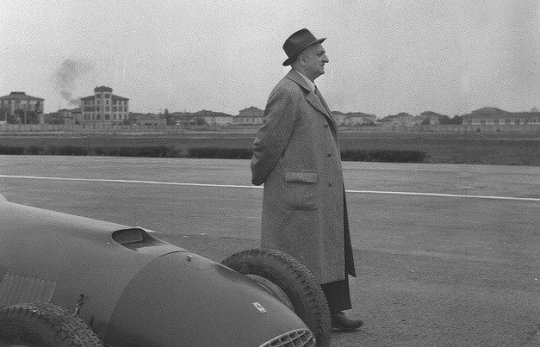
Enzo Ferrari was a man passionate about motorsport and high performance cars. He understood that one of the secrets to success for his young company was to obtain victories in high profile competition events, and an FIA World Sportscar Championship win would be a great feather in Ferrari’s cap - something that would make the motorsport world, and the sports car buying public, to take notice.
The final event for the 1955 season was to be the Carrera Panamericana. It was a gruelling five-day rally that traversed the Mexican wilderness en route to the border near El Paso, Texas. Ferrari had experienced overwhelming success on nearly every circuit in sports car racing, with the one possible exception being the notoriously dangerous Carrera Panamericana. Not for nothing it was known as the most dangerous motor race in the world with accident deaths being the norm each year among drivers and spectators. It’s fearsome reputation was such that it would bring extra kudos to a sports car maker whose car successfully completed the course and won the event.
Previously, in 1952 several privateer Ferraris were entered, including three of Maranello’s latest sports-racers, Vignale-bodied berlinettas built upon the Lampredi 340 racing engine platform. Subsequently known as the 340 Mexicos, these cars showed promise as Luigi Chinetti finished 3rd overall.
But a year later in 1953, the upgraded 340 MM entries could not hold pace with Lancia’s dominating D24 race cars, despite Umberto Maglioli’s commanding 10-minute lead during the race’s final leg. In 1954, Maglioli rumbled to victory in Erwin Goldschmitt’s 375 Plus. Ferrari had failed again. Riding too high to handle safely, these extremely powerful cars clearly required some chassis development to remain in control on the bumpy and unpredictable surfaces of the Carrera course.
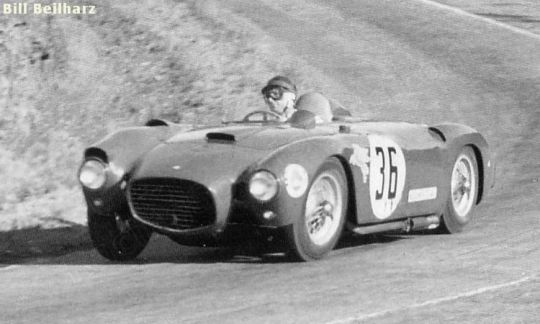
In the years up to 1955 Ferrari campaigned in the event without success and so they went back to the drawing board, literally, and designed a car purpose built for that event. It was designated the type 519/C and the chassis numbers all ended with the initials “CM” which stood for “Carrera Messicana” for the event they were created for.
This new car was the 410 Sport and the second two of the four to be made were fitted with a revised version of the Lampredi V12 engine with a capacity of 4,961 cc. This engine was given dual spark plugs per cylinder (i.e. twenty four in total), a quadruple distributor arrangement, combined with magneto ignition in the first car 0596 CM and coil ignition in the second car 0598 CM.
To feed in a healthy dose of fuel/air mix into those twelve thirsty cylinders three twin-choke Weber 46 DCF carburetors were bolted on in the middle of the “V.”
The suspension system was designed to provide the best handling and durability the engineers could achieve, at the front a fully independent system with upper and lower wishbones, and at the rear a transverse elliptic spring built into a De Dion design.
The roads in Mexico were rough and the suspension was going to need to soak up some exceeding nastiness while keeping the car on course and providing the best ride possible to keep drivers from fatigue. The chassis was a tubular space-frame set for low riding for optimum stability and, they hoped, for survivability over the destructive conditions of the race.
The power of the dual ignition engines was slightly short of 400 hp, which was very high for cars of the period, and it would be this cutting edge level of power that would prove to be the car’s Achilles heel, paradoxical though that might sound.
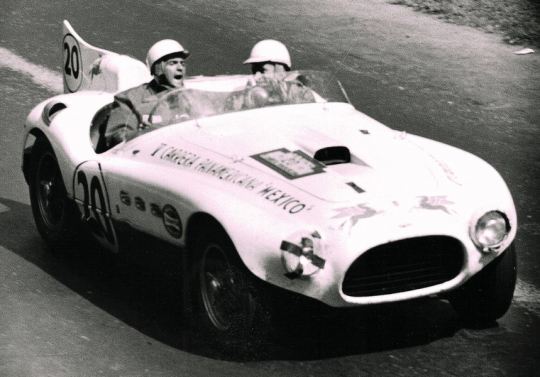
Even as Ferrari’s engineers were designing and building these four the notorious 1954 Le Mans crash took place. This saw a very lightly constructed Mercedes-Benz 300 SLR crash at the end of Mulsanne Straight. With the car traveling at top speed it broke apart in a collision and sent pieces through the spectators at that location, killing 83 spectators and the driver, and injuring about 180 people.
This caused the entire motor-sport fraternity to re-assess their participation in motorsport events, and the organisers cancelled the 1955 Carrera Panamericana. So the two cars Ferrari were working on suddenly did not have the race they were created for to compete in.
As a result, Maranello repositioned the two double ignition 410 S to participate in the 1956 World Sportscar Championship racing season, making their debut at the season-commencing 1000 KM of Buenos Aires in January 1956.
The pair of 24-spark cars, chassis numbers 0596 CM and 0598 CM, were respectively driven by the paired teams of Peter Collins and Luigi Musso, and Juan Manual Fangio and Eugenio Castellotti. The Argentine great, Juan Manuel Fangio preferred the pedals of his cars to be laid out in the old “C.A.B” layout. So from left to right the pedals were clutch, accelerator, and brake. This arrangement was not uncommon during the 1950s and 1960s. Some drivers, such as Fangio, preferred this arrangement for heel and toe gear-changing.
All eyes were on the local hero from Argentina, with the press focusing much of their attention on Fangio and his 410 Sport. But the two Ferrari’s faced stiff competition, especially in the person of British driver Stirling Moss who was so noted for his fast driving that he created the famous line uttered by British traffic policemen when they pulled you over for speeding “Who do you think you are – Stirling Moss?” Moss was driving a Maserati 300S - an extremely fast car - as long as it didn’t suffer a mechanical failure (something they tended to be prone to).
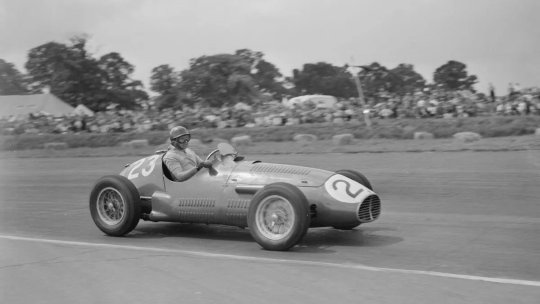
The pair of 24-spark cars, chassis numbers 0596 CM and 0598 CM, were respectively driven by the teams of Peter Collins and Luigi Musso, and Juan Manual Fangio and Eugenio Castellotti. Fangio had requested a special modification to 0598 CM that moved the accelerator from its normal position to one between the brake pedal and the clutch. Disaster hit the Ferrari 0598CM team early when Castellotti experienced a tire issue forcing the car into the pits for repairs. Fangio jumped back in 0598 CM with a significant distance to overcome and furiously chased down Stirling Moss in the leading Maserati 300S. After Castellotti experienced a tire issue forcing the car into the pits for repairs, Fangio jumped back in 0598 CM with a significant distance to overcome and furiously chased down Stirling Moss in the leading Maserati 300S. Moss was happily storming ahead very comfortably from the rest of the chasing pack. But Moss didn’t count on Fangio’s drive to win. Fangio was after all driving in front of a home crowd of fellow South Americans and he really wanted to win – so he drove using all his skills, talent, and ability and he closed the gap with some dramatic driving until he had Moss’s Maserati in his sights.

And it was at that point that Murphy’s rule reared its ugly head - “if anything can go wrong, it will, and at the worst possible moment”. The other Ferrari 0596 CM of Collins and Musso lasted until lap 61 until the transaxle failed. Fangio’s car suffered a similar fate. In Fangio’s car the differential gave way from the punishment enacted by the feverish pace and raw power of the type 126/C engine on the 89th lap. The transaxle failed bringing Fangio’s wild drive to a heart wrenching end. 400 hp had proved the car’s Achilles heel - the engine was too much for the transmission.
The Brazilians mourned Fangio’s elimination from the race, although driving so hard that the car collapses under the strain is a pretty heroic way to withdraw. However heroic the effort was, Ferrari and his entire team including the drivers were devastated.
Ferrari sent both cars back to the factory for a refit. It was this point the fate of the Ferrari 410 S would take a momentous turn of fortune in 1956.
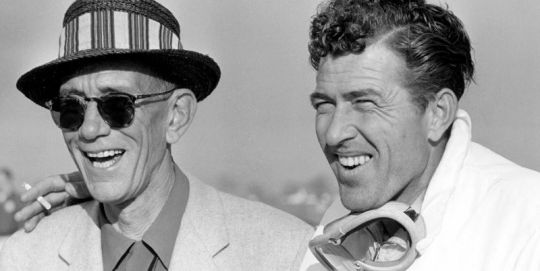
Racing team owner John Edgar had taken note of the two Ferrari 410 S fitted with the dual spark plugs and quad distributors and had set his sights on getting one. John Edgar had waited in the wings for his opportunity at 0598 CM, anxious to obtain the golden chariot that might deliver his own racing championship. Edgar had also taken note of a young American driver who had given up his life as a chicken farmer to take up motor racing. That ex-chicken farmer was of course none other than the future legendary driver, Carroll Shelby, and John Edgar wanted to recruit him to his racing team and put him in the driver’s seat of a 400 hp 410 S.
Not only John Edgar was able to purchase 0598 CM, the Fangio/Castellotti car, but he was also able to lure Carroll Shelby away from Scuderia Parravano with the promise of turning him loose in the Ferrari. Shelby loved speed, so much that despite his heart condition he did as much high quality motor racing as he could get: even though he had to keep a nitro glycerin pill under his tongue to help with his heart condition. It would be this heart condition would ultimately force him to stop racing – but Shelby was determined to get the maximum enjoyment in the sport before that happened.

While awaiting the delivery of 0598 CM, Shelby garnered a number of wins for Team Edgar at smaller venues, winning the “Race to the Clouds” at Mount Washington, New Hampshire, the Laurel Run Hillclimb, the Brynfan Tyddyn, and the Breakneck hillclimb outside of Cumberland, Maryland. But the central attraction was scheduled to arrive by airfreight in August 1956 at San Francisco, where the tireless team mechanic and hauler Joe Landaker picked up the 410 Sport and transported it to Bremerton, Washington for the 1956 Seafair event.
In his inaugural race in 0598 CM Shelby took the checkered flag, setting the stage for many more victories to come. The Shelby/Ferrari 410 S combination proved to be formidable. The 1956 Washington Seafair event and followed it up with a number of impressive victories. Shelby went on to a number of victories in the 410 S that year in 1956. With Shelby’s victories came telegrams sent to John Edgar by none other than Enzo Ferrari, who seemingly took an active interest in Shelby’s continued success behind the wheel of 0598 CM, congratulating him on more than one occasion.
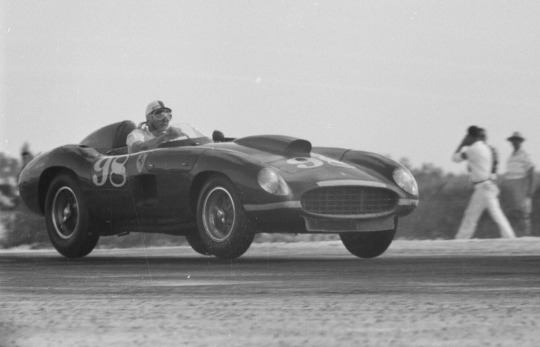
At the season-concluding SCCA finale at Palm Springs in early November, Edgar entered six cars, hotly pursuing the elusive championship. The 410 Sport had been dubbed “Edgar’s Modena Monster” by the press, and with Shelby at the wheel, there seemed to be no race it could not win.
Shelby won the pole position during Saturday’s preliminary race at Palm Springs, facing a challenging field that included Phil Hill in a Ferrari 857 Sport, fresh from his rookie year with the Ferrari factory team (one that brought the FIA’s 1956 World Sports car Championship to Maranello). From a 3 PM standing start, Bill Murphy jumped out to the lead in his Buick-powered Kurtis, though he was quickly overtaken by Shelby and Hill. Through the corners, Hill’s nimble 857 S would get the upper hand as Shelby braked hard, then on the straightaways Carroll would pour on the 4.9-litre power to retake the lead.
This pattern repeated time and again throughout the race, with Shelby managing to finish first at each lap’s conclusion. In the final lap the two cars battled side-by-side until Shelby roared to victory, just a half-second ahead of Hill.

Shelby later quipped that with his power advantage he could have taken a bigger lead over Hill at any time during the race, but was having too much fun enjoying their epic duel. The captivating Texan had won the race, capping a season in which he won 40 different events, including 18 feature races. Four months later his infectious grinning mug graced the cover of Sports Illustrated magazine, which pronounced him the US Sports Car Driver of the Year for 1956 - his celebrity had transcended to a greater stage.
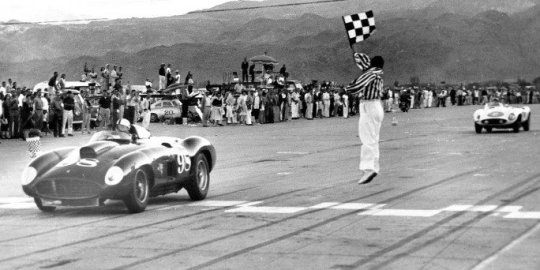
As the 1957 season dawned, John Edgar continued to pin his hopes on Shelby in the 410 Sport, and though Carroll failed to qualify at a rain-soaked Pomona race in January, he achieved two wins in February at New Smyrna Beach, Florida. The first Cuban Grand Prix was held in 1957 along Havana's waterfront, the Malecon, and by all accounts it had been a huge success. Juan Manuel Fangio, whose tally of five world championships has been surpassed in the decades since by just Lewis Hamilton and Michael Schumacher, was favourite to win.
Shelby’s success though set up an epic duel at the ritzy Gran Premio de Cuba, a 310-mile race of 90 laps through the streets of Havana and along the beachfront Malecón. The Cuban revolution was in full swing, but of course sports car racing should happen regardless of mere revolutions and so the Gran Premio de Cuba was organised with the race to take over the streets of Havana and bring the un-muffled roar of racing engines along the beachfront at Malecón. Filming the race from the perch of his hotel room balcony, John Edgar watched as Shelby’s 410 Sport held off Portago eventually finishing in 2nd place, 60 seconds behind Juan Manuel Fangio’s Maserati 300S.

From this point forward Edgar began to court Maserati, eventually agreeing to a deal in which Shelby would pilot a 450S, Modena’s prodigious new V-8 powered sports-racer. Maserati later struggled to deliver the car, and instead offered a 300S loaner during the interim. As the contract with Maserati specified that Shelby could not drive a Ferrari under any circumstances, Edgar was content to put Phil Hill in 0598 CM for the Hawaii Speed Week in April 1957. Hill shortly left the Edgar fold for good to race for Scuderia Ferrari at Le Mans.
John Edgar had sunk nearly half a million dollars into the construction of the new Riverside International Raceway, and after Shelby was hurt in a crash of one of the Edgar Maseratis, Richie Ginther was pressed into action in the Ferrari 410 Sport at the venue’s September 1957 debut. Richie Ginther was to discover the joys of the “Modena Monster” as 0598 CM had come to be called. And in it he won the first feature race at the Riverside International Raceway. From 5th place in the starting grid Ginther looked ahead at some daunting competition, including Chuck Daigh in a Troutman-Barnes Special, Bob Drake in a Ferrari 375 Plus, and Pete Woods in a Jaguar D-Type. Not to be deterred, Ginther took the lead after 22 laps, and he went on to roar to victory behind the wheel of 0598 CM - winning the first feature race ever run at Riverside as a result.

Ginther had a number of second place victories that year before 1958 arrived and with it a return to Cuba, still in the middle of a revolution. But last time the cigars were good and the enjoyment was fabulous - so what could possibly go wrong?
The 1958 Gran Premio de Cuba was ill-fated in so many ways. Not only was the race eventually stopped because of a on track accident, but Juan Manuel Fangio was kidnapped by Cuban communists and Stirling Moss almost shared the same fate.
Fangio came back to defend his title, and alongside him on the grid was a host of other big names from the era, including Stirling Moss. The drivers approached the non-championship race as any other, and the most famous were accommodated in the luxurious Hotel Lincoln in Central Havana.
On the eve of the grand prix, Fangio walked into the lobby of the hotel on his way to dinner, only to be confronted by a young man in a leather jacket brandishing a pistol.According to reports from the time, the slightly nervous assailant barked: "Fangio, you must come with me. I am a member of the 26th of July revolutionary movement." One of Fangio's friends picked up a paperweight and moved to throw it at the intruder, but the pistol jerked round. "Stay still," the kidnapper said. "If you move, I shoot." And with that Fangio accompanied the young man to a waiting car.

The motive was simple: by capturing the biggest name in motorsport the revolutionaries would show up the government and attract worldwide publicity to their cause. Yet despite the news of the kidnapping spreading across the globe, Batista refused to be outdone and ordered the race to continue as usual while a team of police hunted down the kidnappers.
Meanwhile, Stirling Moss was kept under guard throughout the night, with a watchman knocking on the door every three hours to make sure he was still in his bed. "It was a very disturbing night," he recalled. "Fangio told the rebels, 'You mustn't take Stirling because he's on his honeymoon' - which was a lie of course, but nevertheless was very decent of him."
In an unknown location, Fangio was taking it all in his stride and was being treated to a slap-up meal of steak and potatoes before "sleeping like a blessed one" in a well-furnished apartment. Convinced he was not in danger, he later said he sympathised with his captors' actions."Well, this is one more adventure," he added. "If what the rebels did was in a good cause, then I, as an Argentinean, accept it."
As ordered by Batista, on the morning of the race, the cars were fired up in front of a 150,000-strong crowd, with Maurice Trintignant filling in at Maserati for the missing Fangio. By this time the world champion had been offered a personal apology by Castro's man in Havana, Faustino Perez, and had even been supplied with a radio so he could listen to the action. But Fangio was not in the mood."I became a little sentimental," he said. "I did not want to listen because I felt nostalgic."
It was just as well, as Fangio's sentimental state of mind could have been pushed to the limit had he known what was happening on track.
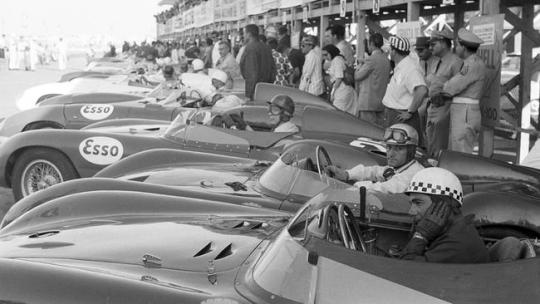
The race got underway as normal without Fangio. It was going to be a close fight even without Fangio there. Masten Gregory drove the ‘Modena Monster’, now called the Edgar 410 Sport, admirably, passing the brilliant Stirling Moss in a Ferrari 335S and building on his lead. But by the time the leaders started their fifth lap, almost every corner of the 3.5-mile circuit was slick with oil and the cars started to run perilously close to the barriers.
At first the organisers suspected a second act of rebel sabotage, but it was later discovered that Roberto Mieres' Porsche had a broken oil line.
On the next lap, disaster struck. Local driver Armando Garcia Cifuentes lost control of his yellow and black Ferrari and went head on into a bunch of spectators lining the circuit. Over 30 people were injured and seven killed as the wreckage took out a makeshift bridge and flew over the crash barriers. Porsche driver Ulf Noriden stopped on track and attempted to help."I couldn't even see the Ferrari," he said. "The bodies were piled all over. I was wading in arms and legs."
After a Ferrari left the track due to an oil spill and went into a crowd of spectators, the race was red flagged with Gregory’s ‘Modena Monster’ in 1st place. Believing he had won the race, Gregory lifted off the throttle. Moss soon flashed past him at full speed. Moss, unaware of the extent of the tragedy, continued racing against Gregory’s Ferrari. A confused Gregory watched in horror as the checkered flag signalled Moss the winner at the finish line. It was one of the most bizarre victories of Moss’ illustrious career.
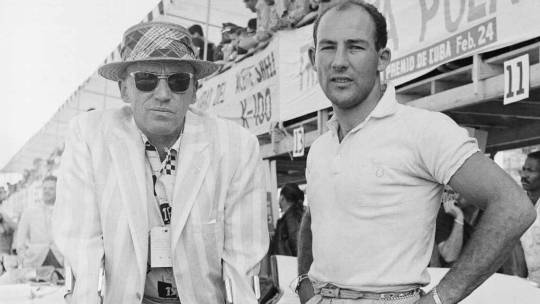
Moss explained soon after to a furious 2nd place-finishing Gregory that red flag rules required the final lap to be completed before determining race results. Moss realised Gregory would have won the race if not for his confusion over this technicality, and in true gentlemanly fashion, he split his race earnings with Masten 50/50.As Stirling Moss was to explain it years later, “"So I said to Masten, 'Look, keep quiet, we'll pool our prize money together and then split it'. And that's exactly what we did, because otherwise it would have gone to the organisers or whoever to decide and it would be years before we got the money, if we got it at all. So officially I was the winner. The truth was either of us could have won it, but what the hell, it didn't matter. Why have an argument about it? Especially with everything else that happened that weekend."
But in the bigger picture it meant that Jack Edgar and the Ferrari Modena Monster were denied sweet victory in the 1958 Gran Premio de Cuba.

For Carroll Shelby the sun was rapidly setting on his racing career.
In 1958, Carroll Shelby demanded to take one last drive in his trusted 0598 CM after the Maserati 450S was sidelined due to mechanical issues prior to the Palm Springs main event in April of 1958, breaking the Maserati contract requirements in the process. Back in the hands of Shelby, the 410 Sport responded commendably, finishing 2nd overall. It was to be Shelby’s last race in 0598 CM – a good finale for his man and machine team.
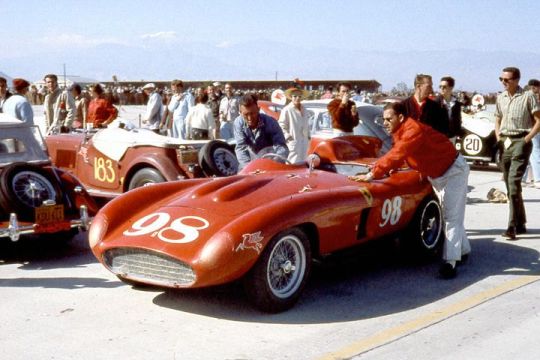
For Carroll Shelby loved 0598 CM as the best Ferrari he’d ever driven - and he’d had the opportunity to drive it in motor racing in the 1950s which he regarded as a golden age of motorsport by many. Reflecting on his time with Edgar and the 410 Sport Spider, Carroll Shelby would later tell John Edgar’s motor racing journalist son, William Edgar, “Racing in the 1950s was really and truly some of the best times of my life, and it’ll never be replaced. It was an era that’s gone and won’t ever be back.”
1959 signalled the last year of competition for John Edgar, as financial pressures increased and resulting sponsorship concerns began to cloud the landscape. Edgar made his last-gasp attempts to win the USAC Road Racing Championship but failed. It was the sign to pack up and leave the sport with some level of pride and satisfaction at his team’s racing achievements.

Following its stellar racing career, John Edgar sold 0598 CM to Luigi Chinetti in 1960. The car was pulled out of retirement and prepared for the 1963 Daytona Continental 3 Hours for NART driver “Fireball” Roberts. Racing regulations, however, had changed since the last time 0598 CM took the track. The rules now stated that cars were required to have a fixed roof, which necessitated the fashioning of a crude hardtop so 0598 CM could compete. After practice laps proved the improvised hardtop was slowing the car too significantly to qualify, 0598 CM went back into retirement.
Chinetti hung onto the 410 Sport for over two decades until he sold it to private collector. From there it passed through a few private owners.
During its illustrious history, Maranello has built several very significant sports-racers that started life as Scuderia team cars and later became legendary in American privateer circles, but very few of these can compare to 0598 CM. As the car that propelled Carroll Shelby to national attention, and the most successful racer of the respected John Edgar team, this 410 Sport may be regarded as nothing short of a legend. It is indubitably rare, being one of just two factory-campaigned examples that were fitted with the more powerful twin-plug-per-cylinder version of the large-displacement 4.9-litre Lampredi long-block V-12.
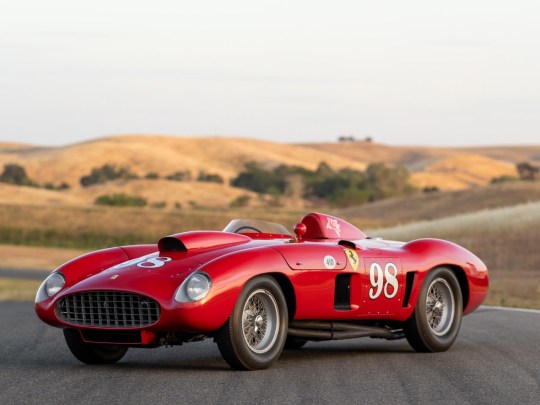
Driven by a who’s who of the era’s greatest racing drivers, including Juan Manuel Fangio, Eugenio Castellotti, Carroll Shelby, Phil Hill, Richie Ginther, Masten Gregory, Joakim Bonnier, Bruce Kessler, Jim Rathmann, and Chuck Daigh, 0598 CM is without exaggeration one of the most important and colorful Ferraris to compete in racing during the 1950s.
The Ferrari 410 S 0598 CM may have been retired from active competition for several decades but it had enjoyed a pampered retirement over the years since it earned itself the legendary nickname, the ‘Modena Monster.’
As a postscript, in August 2022 the Ferrari 410 S 0598 CM, long forgotten by the public, but not by petrol heads and racing fans, came out into the public glare again. The ‘Modena Monster’ was put up for an auction sale by RM Sotheby’s in California. It was sold for around $22 million.

While the memories of the incredible World Sportscar Championship have gradually begun to fade, still-salient names like Fangio, Moss, Bandini, and Shelby provide a tangible link to the past. What makes those links stronger are these magnificent cars themselves that will always carry the memories of these iconic drivers in their engines and coach work design from the leading carrozzerie of Turin and Milan.
As one of a select few Ferrari models with coachwork both designed and built by Sergio Scaglietti and the iconic drivers who had driven her, the Scaglietti-built spider was a unique, powerful, and complex character that cannot be copied. As such its achievements will always have a place in motorsports lore amongst racing fans and petrol heads.
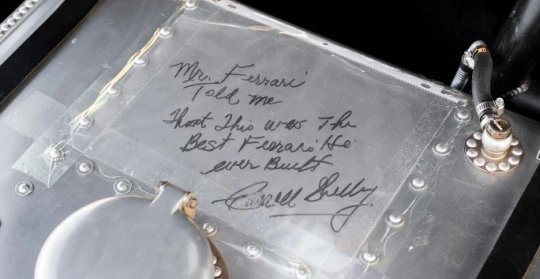
Six years before his death in 2012, Shelby was reunited with 0598 CM at the Fabulous Fifties Concours in Gardena, California. It was there that the iconic American driver added an unforgettable inscription to its 195-litre fuel tank: “Mr. Ferrari told me that this was the best Ferrari he ever built.”
Perhaps no higher praise could be envisioned for 0598 CM.
#ferrari#enzo ferrari#quote#maranello#sergio scaglietti#scaglietti#italian#sports car#racing#motorsports#ferrari 0598 CM#ferrari 410 sports#ferrari sports spider#john edgar#carroll shelby#juan manuel fangio#stirling moss#grand prix#formula one#speed#modena monster#design#engine#motor racing history#essay
80 notes
·
View notes
Text
Motorcycle Drivetrains: Understanding the Three Types and Their Unique Benefits
https://gob.stayingalive.in/unleashing-the-thrills-of/motorcycle-drivetrains.html Discover the world of motorcycle drivetrains! Learn about chain, belt, and shaft drive systems, their efficiency, advantages, and which one reigns supreme. #MotorcycleLife #RidingExperience The Heart of Motorcycle Performance Motorcycle drivetrains are the unsung heroes of the riding experience. These systems…

View On WordPress
#automotive#Belt drive motorcycles#cars#Chain drive motorcycles#Drivetrain technology#Electric motorcycles#Future motorcycle technology#Good Old Bandit#Gud Ol Bandit#Hybrid motorcycles#Lightweight materials#motorcycle#Motorcycle drivetrains#Motorcycle efficiency#Motorcycle maintenance#Motorcycle performance#News#Sanjay K Mohindroo#Sanjay Kumar Mohindroo#Sanjay Mohindroo#Shaft drive motorcycles#Smart drivetrains#Sustainable motorcycles#technology#touring motorcycles
0 notes
Text
What Is the Difference Between AWD and 4WD?
When it comes to vehicle drivetrains, two terms often create confusion among drivers: All-Wheel Drive (AWD) and Four-Wheel Drive (4WD). Understanding what sets these systems apart is crucial for making informed decisions, especially when purchasing a vehicle suited for specific driving conditions. The difference between AWD and 4WD lies not just in their names but in their mechanical operations,…
#2WD#4WD#all-wheel drive#auto technology#automatic#AWD#car advice#Car Buying#car comparison#car facts#Car Features#car guide#car systems#Car technology#cars#center differential#drivetrain#driving conditions#driving dynamics#driving tips#everyday driving#Four-Wheel Drive#fuel efficiency#gear systems#Handling#Manual#off-road#off-roading#on-road#performance
1 note
·
View note
Text
Rimac Automobili
Goran Just posted a video on his instagram... Uh? No, you're not dreaming ahha!
"Something truly amazing I've been working on... 😊... Big reveal June 26th...😎" #Verne @rimac_automobili
and he tagged Rimac Automobili which is a Croatian automotive manufacturer headquartered in Sveta Nedelja, Croatia, that develops and produces electric sports cars. Its sister company, Rimac Technology also produces drivetrains and battery systems for automotive businesses.
Well, I can't wait to see this! Here's the video that Goran published on his instagram :)
4 notes
·
View notes
Note
hi hazel!
i know this is probably annoying to ask so extremely sorry about this in advance but i’ve been seeing this debate on twitter and it’s so conflicting and I can’t pretend to know enough to understand what people mean by it.
max and christian horner had their opinions that came out about the 2026 engine regulations (as did Damon Hill, Karun and Alex Brundle) and i know they weren’t the most positive. I’ve seen BrrrakeF1’s opinion of it isn’t great either. but i’ve also seen some tweets from others that the regs aren’t bad. (i haven’t really seen any other team mention anything about the 2026 regs except redbull and maybe toto said something)
so are they bad? or good? i know it’s not as simple as that, of course but there seems to be a bit of a fight brewing around this now which i wasn’t actually aware of before.
I think the main problem is that 2026 is effectively tomorrow, in terms of developing a completely new power unit concept and that some ambiguities and potential changes are still in the works.
(this got long)
(also this is not an annoying ask anon! I actually know about power units haha - it's the wag stuff I don't know anything about)
2026 moves to 50-50 internal combustion and electrical power to the drivetrain. That is a big shift from the current hybrid systems, which are somewhere around 8-11% electric power. That's not an exact number; the overall output of an ICE and of course the hybrid system is both down to how efficiently it's running and any constraints on its performance (needing to run the ICE lower for reliability etc) as well as a regulatory maximum of 120kW contribution from the motor.
But it's somewhere, ideally, around there. At most tracks, obviously some of them like Monaco there's less call for maximum power output but you get the idea, it's going to be a big shift.
There are lots of other changes, in how that number is got to; MGU-H is going, which is a pretty uncontested idea. MGU-H is (basically, I'm oversimplifying but) a turbine that runs off exhaust gases and given that, of course only applies to hot-running petrol/diesel combustion engines.*
That's not a technology that's either practical for road cars or the direction that OEMs are taking development in, as well as being expensive and complicated. It was repeatedly cited by manufacturers as a reason not to come back or join F1, so removing it was a done deal.
MGU-K is a non-negotiable part of a hybrid system, it's the part of the powertrain that recovers energy from braking but is also the motor, like in an electric car. Nothing goes to the drivetrain from the electric parts without MGU-K, so that was of course staying and the increased importance of it comes with the development of motors for EVs. Especially recovery systems from braking and lift/coast for range extension.
With that, you need a battery and an inverter and a control system, etc. The scale-up of that to be a larger percentage of the overall power does add weight to the overall power unit and there isn't a way around that, although cars will also be lighter (at race start) due to lower fuel loads.
(worth saying that F1 is currently heavier, at full fuel load, than Formula E; trying to have both is in some ways the worst option)
None of that is really bad or good or what's being argued over, which is a second set of regulations around active aero. In order to compensate for the cars being heavier, in theory at least, the bodywork will actively shift to reduce drag on straights. Like DRS but in a more complex, whole-car way.
"Wait, that sounds insane and also like it would need lots of additional wiring and movement systems to engineer" yea.
I personally think it's a driver aide, if it's not entirely controlled by the driver and also that it's unnecessary. The 919 LMP1-H ran at close to 50% electric energy a lot of the time and it only had a few different aero configurations for the year, let alone a lap.
The active bodywork will need to work closely with the PU, which of course is always the case with a car's bodywork; airflow and cooling the power unit (or even just a pure combustion engine, which of course literally needs to breathe) are essential parts of making a car efficient. But this is more than packaging, it's that parts of the chassis will need to respond to the same ECU as the power unit.
And none of that is really clarified yet. Which given the development lead times is a huge problem. So: it's not that the regulations are good or bad yet, per se it's that they are not yet settled. *Differentiating between hot and cold running because race cars obviously run like blast furnaces compared to a road car, even if you compared two V6s. But also because if you were to apply MGU-H to, for instance, a hydrogen combustion engine, then it would be very inefficient and not generate anything because of the different exhaust outputs.
25 notes
·
View notes
Text
We Don't Have Electric Cars (sic)
We have electric drivetrain cars. The reason this is important is that with gasoline, generation, storage, and usage are all combined together in gasoline.
For electric cars, we need to generate the electricity somewhere. It then has to be stored.
In order to replace gasoline/diesel cars with electricity, we'll need to at least double our electricity production, and in some places quadruple local grid capacity.
And no, that's no an exaggeration. The F-150 Lightning can store enough power to power an average US household for 3 days. Which means if you are charging it, you need enough electricity to power the household, and then add triple that capacity for the truck.
The only way we have to produce this much electricity in a reliable way is Nuclear.
As for storage, most cars use chemical storage. Chemical cells produce power through the differing electrical potential between metals. If you put an electrolytic fluid between them, (a fluid that can carry an electrical current), then electricity will flow. You can then put an electrical circuit between both ends.
We've developed rechargeable ones, but they degrade with every - single - charge. We've also reached the limit of this technology, and it requires elements that... are either mainly produced in China, (who doesn't want to share), or are mined by child slaves in Africa.
To be entirely fair, chocolate has a child slavery problem as well. We should maybe fix these issues, this is more focused on the technology.
Other storage mechanisms include supercapacitors. Supercapacitors can only store 5% of an equivalent lithium-ion battery, but can be fully charged in minutes. This means they do not have the range of chemical batteries, often only having a range of a few miles. But, if you take something that stops every few miles, and has a regular route, such as a bus, then this makes sense. There are countries trying it out right now.
Capacitors involve... honestly... tricking electricity. Electrical circuit can involve electrons flowing, or it can have electrons moving enough to get the next electron to move. You can create a circuit that allows the potential to travel along the circuit, while the electrons themselves get trapped.
Other methods involve mechanical storage, which literally means flywheels. This might seem a bit silly, but compulsators, Compensated Pulsed Alternators, use flywheels to store energy, and is the best way to turn a regular current into an extremely strong pulse. This is what they use for railguns, (tl;dr on railguns, materials are the problem).
There are other forms of storage, that don't have the problems of chemical storage, but are difficult to miniaturize. This makes them useful for grid storage.
The best storage we have for an electrical drive train is hydrogen. It never went anywhere, as the governments stopped pretending to care about it. But that's for the next post.
5 notes
·
View notes
Text
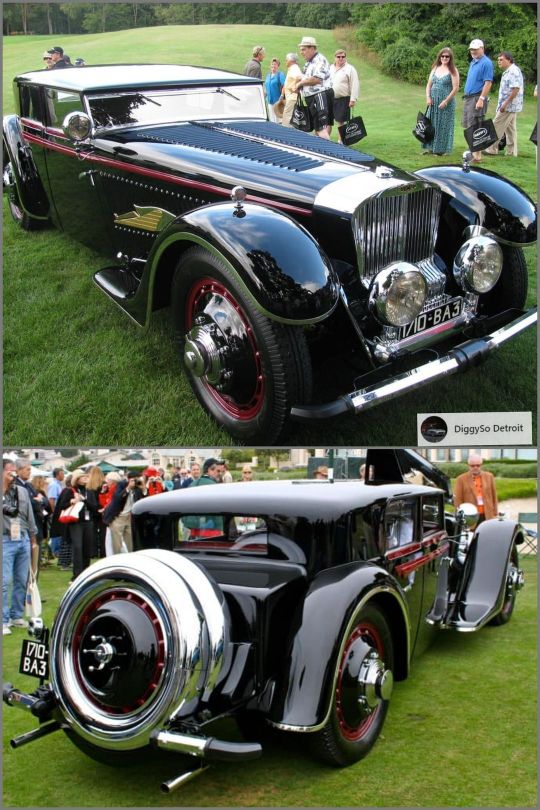
1932 Bucciali TAV 12 "Golden Arrow" by Saoutchik
Paul-Albert Bucciali built only six cars between 1926 and 1932. They were built to display the front-wheel-drive system Bucciali invented. Bucciali received an American patent and licensed his technology to Peerless Motor Car Company of Cleveland, Ohio. Unfortunately for Bucciali, Peerless never used the license.
This Bucciali features a specially designed Voisin V12 sleeve-valve engine with four carburetors. Drive to the front axle is through a four-speed transaxle. The huge wheels, fabricated from steel, have integral brake drums. The coachwork is by the French Carrozzeria Saoutchik. The distinctive stork on each hood side is made from German silver, phosphor bronze, and gold-plated brass. This stork was the insignia of Bucciali's WWII fighter squadron. The original chassis price was an incredible 130,000 Francs, and the coachwork was an additional 85,630 Francs. Only one Bucciali was sold to the public. This is it!
The original owner, George Roure, displayed his Bucciali at the 1932 Paris Auto Show. Subsequently, he sold it to Count de Rivaud, who later mounted the body on a more maneuverable Bugatti chassis. In the 1970s, the body was reunited with what remained of the Bucciali chassis and drivetrain, and after a long, challenging restoration, the Bucciali was returned to its original state. The work was begun in Detroit by the noted collector Raymond Jones. In addition to using many factory blueprints, Paul Albert Bucciali was consulted for special detail as to the colors and design of the interior. The car now appears exactly as displayed at the Paris show in 1932.
Starring at the 1932 Paris Auto Show, the front-wheel drive, twelve-cylinder, sleeve-valve engined Bucciali stunned show-goers. Cloaked in one-off coachwork by Saoutchik, the car received acclaim as the most advanced and modern French automobile.
The Bucciali was sold originally to a Paris banker, who drove it for three years. The coachwork was then removed and fitted to a Type 47 Bugatti chassis. The Bugatti fitted with the Bucciali's coachwork was sold and brought stateside after World War II. The original chassis remained behind in France.
In the 1970s, the Bucciali body was reunited with the original chassis, which was purchased from a French collector. With the assistance of Paul Albert Bucciali, the car was restored to the original, spectacular state that it is today.
73 notes
·
View notes